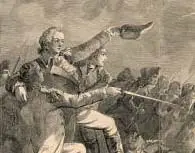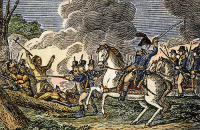'Mad' Anthony Wayne
Anthony Wayne was a Revolutionary War veteran who made a name for himself in two battles, one of which earned him the nickname "Mad." 
He was born in 1745 at Waynesborough, in Chester County, Penn. Young Anthony attended his uncle's private school in Philadelphia, showed an early interest in mathematics, and trained as a surveyor. He spent a bit of time surveying professionally, surveying land in Nova Scotia, before returning to the family farm. He worked for a time at his father's tannery. Wayne was a member of the Pennsylvania legislature in 1774–1775. When the Revolutionary War began, Wayne organized a militia unit and ended up as the colonel in charge of the 4th Pennsylvania Regiment. He and his men soon saw action, in support of Benedict Arnold's unsuccessful invasion of Canada. Wayne was wounded at the Battle of Three Rivers, a stinging defeat outside Quebec. Despite the outcome, Wayne deftly organized his regiment's retreat, so they could fight another day. 
Wayne was promoted to brigadier general in 1777. For a time that year, he was commander of Fort Ticonderoga. and led his men into battle at Brandywine, a Sept. 11, 1777, clash between George Washington's Continental Army and Sir William Howe's British Army that ended with the British victorious and on the verge of seizing Philadelphia (which they did two weeks later). Wayne's string of defeats continued with what has become known as the Paoli Massacre, a disastrous surprise attack on his forces by British Gen. Charles "No-Flint" Gray, who earned the name by ordering his troops to fight with bayonets only, completing the surprise attack by not firing their guns. Wayne lost 158 and, despondent, sought to place his fate in the hands of a military court-martial tribunal. The resulting inquiry refused to condemn Wayne and ordered him to keep fighting. He and his men took part in the Battle of Germantown, another American defeat. The army kept on retreating, ending up at Valley Forge. Wayne survived the harsh winter there and was again on the move. In the summer of 1778, he sought and got permission from Washington to attack British forces at what came to be called the Battle of Monmouth (at which Molly Pitcher earned her nickname. The Americans held the field in the end, earning Wayne a much-needed victory. He got another one soon enough. 
Stony Point was a strongly defended British fort at King's Ferry on the Hudson River. On side of the fort was a swamp; water surrounded the other three sides. The fort was on top of a bluff 150 feet high. Defending the fort were more than 500 British soldiers. The British thought that the fort was impregnable. Wayne, known for keeping his cool under fire, took a force of 1,200 light infantry and launched a surprise night attack, on July 15, 1779. Wayne had planned his attack well, and this, coupled with the element of surprise, won him the day. He was wounded in the head but kept on, leading his men to victory. American losses were 15, British losses were 94, and American troops now commanded the fort. The attack lasted just 30 minutes, and the Americans employed only bayonets as weapons, turning the tables on the British as they had done to Wayne at Paoli. It was for this attack that Wayne got his nickname of "Mad," for his daring attack in the face of what had seemed overwhelming superiority on the part of the enemy. (Another origin story of the nickname is that he acquired it much earlier in his career, from someone who thought him too rash in his actions. Wayne was known for his lightning-speed attacks and was caught out more than once by advancing too quickly. In 1780, Wayne gained command of two Pennsylvania brigades for an attack on Bull's Ferry, near New York City. The British held the position. Wayne was commanding officer of the Pennsylvania Line when a number of those soldiers mutinied. Wayne's firm hand resulted in the dismissal of a number of the rebellious soldiers and the replacement of those who he had dismissed. Washington then ordered Wayne to move southward, and he and his men eventually met up with the Marquis de Lafayette and other commanders in what would become the siege and eventual victory at Yorktown. Before they got there, however, Wayne gained even more prestige by holding out against a larger force at the Battle of Green Spring by launching a surprise bayonet attack and then retreating in an orderly fashion. British General Charles Cornwallis, who had defeated Wayne at Green Spring, had surrendered at Yorktown, but the war wasn't over just yet–not in the south, anyway. Wayne took a contingent of troops to Georgia and South Carolina, which had long been occupied by British forces. A series of skirmishes later, the British left Savannah, on July 11, 1782. He then occupied Charleston, ending the British occupation there. The Treaty of Paris of 1783 officially ended the war. In that year, Wayne was promoted to major general. Wayne, in ill health, returned home to recuperate. He later served in the Pennsylvania Assembly and was a delegate to the Constitutional Convention. He also lived in Georgia for a time, on a rice plantation given to him for his role in pacifying the Native Americans there. He represented Georgia in the House of Representatives in 1791–1792. Then-President Washington appointed Wayne Commander of the U.S. Army of the Northwest in 1793 and ordered him to the Northwest Territory to help facilitate American settlement of that area, which at the time was a hotbed of conflict between Americans and a combination of Native Americans and British. The Treaty of Paris that ended the Revolutionary War had handed control of this area over to the Americans, but British forces did not abandon their forts. British troops also actively supported Native Americans in their efforts to hold on to their lands in the face of continued American settlement. Wayne was a war hero and a proven military strategist. After the war, he had negotiated treaties with the Cherokee and Creek tribes in Georgia. Washington was counting on both areas of Wayne's expertise. The colorful Wayne took charge of the area's militias and turned them into more of a professional army known as the Legion of the United States. Wayne was aiming to succeed where two of his predecessors, Josiah Harmar and Arthur St. Clair, had failed. Both had engaged Native American forces on the field of battle and had been defeated. Harmar made relatively little progress in 1790, losing dozens of men in skirmish after skirmish. St. Clair fared no better, suffering a particularly disastrous defeat in 1791 that claimed the lives of more than 600 people. Wayne had brought a contingent of professionally trained troops and arrived at Fort Washington, near what is now Cincinnati, in May 1793. The troops drilled and drilled, aiming to avoid past mistakes. They moved from fort to fort, eventually building a new one, Fort Greene Ville, where they spent the winter. The men also built Fort Recovery, on the site of St. Clair's defeat. The territory was large, and both Wayne's force and what would end up being his main enemy operated in different areas for a time. Leading the alliance of Native Americans were Miami chief Little Turtle, Shawnee chief Blue Jacket, another Shawnee fighter who would rise to prominence named Tecumseh, and members of the Lenape, Myaamia, Ojibwa, Ottawa, and Wyandot tribes. On June 30, 1794, Little Turtle and 1,500 other Native Americans attacked a supply train leaving Fort Recovery, killing or capturing many of the Americans and seizing the supplies. As a result, Wayne ordered the construction of another fort, Fort Defiance. He also ordered his men to destroy the homes and crops of many Native Americans living nearby. 
By this time, Wayne had a fighting force of 3,000 well trained men. The Native American alliance had lost a significant number for various reasons and had not been replenished, and the remaining force was about half that of the Americans. Both sides prepared for conflict. Wayne's forces marched up the Maumee River. The Native American alliance chose the battlefield, near where a number of trees had been felled by a tornado. The battle occurred on August 20. Among the leaders of the Native American alliance that day were Blue Jacket, Little Turtle, Lenape chief Buckongahelas, Ottawa chief Turkey Foot, and Wyandot chief Roundhead. 
The American forces won the day. American deaths numbered 33, with 100 wounded. Native American casualties were about twice that. Blue Jacket and his followers moved to Fort Miami, looking for support from British forces, who were still very much in the area. This time, the fort would not open its doors. Wayne arrived and ordered the British to leave the territory; he was rebuffed. Wayne set up headquarters at Fort Greene Ville and spent the next year working out the terms of a treaty with leaders of the various tribes. The result was the Treaty of Greenville, signed nearly a year after the Battle of Fallen Timbers. Tribal leaders agreed to give up their lands to American settlers and move to the northwestern part of what is now Ohio. Wayne returned home after concluding the treaty negotiations and stayed there for a time. In 1796, he was back out west, with headquarters at Pittsburgh. He had already suffered one bout with ill health, and he had been wounded twice in battle. He suffered a terrible case of gout in late 1796. He was at Presque Isle when he died, on December 15. He was buried there. Wayne was survived by his wife, Mary, and a daughter, Margretta, and son, Isaac. |
|
Social Studies for Kids
copyright 2002–2025
David White




